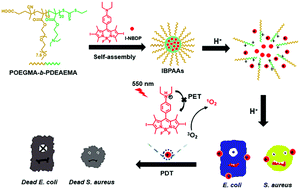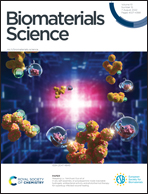An acid-triggered BODIPY-based photosensitizer for enhanced photodynamic antibacterial efficacy†
Abstract
Photodynamic inactivation of bacteria has emerged as a promising antibacterial strategy due to its high antibacterial activity and low bacterial resistance. Herein, an acid-triggered photodynamic antibacterial nanoplatform (IBPAAs) was constructed by co-assembly of an acid-triggered photosensitizer BODIPY (I-NBDP) and the POEGMA-b-PDEAEMA block copolymer for enhancing the antibacterial efficacy and biofilm-dissipation capability. IBPAAs could have great biocompatibility and stability by the formation of self-assemblies, and it could be cleaved to release the I-NBDP photosensitizer under a dual-step acidic response due to the protonation of the diethylamino groups on both I-NBDP and the POEGMA-b-PDEAEMA block copolymer. On the one hand, the photoinduced electron transfer (PET) of I-NBDP in IBPAAs under neutral conditions could be attenuated, resulting in an increase of its 1O2 yield, effectively improving its photodynamic antibacterial efficacy. On the other hand, the protonation of IBPAAs made it easier to target negatively charged bacterial surfaces, further enhancing its photodynamic antibacterial activity. The antibacterial experiments in vitro showed that the IBPAAs assemblies had great photodynamic antibacterial efficacy and biofilm dissipation capability, and it could effectively relieve bacterial infection of wounds and accelerate wound healing in vivo. Therefore, this acid-triggered strategy is expected to provide a new path for enhanced photodynamic antibacterial therapy.



 Please wait while we load your content...
Please wait while we load your content...